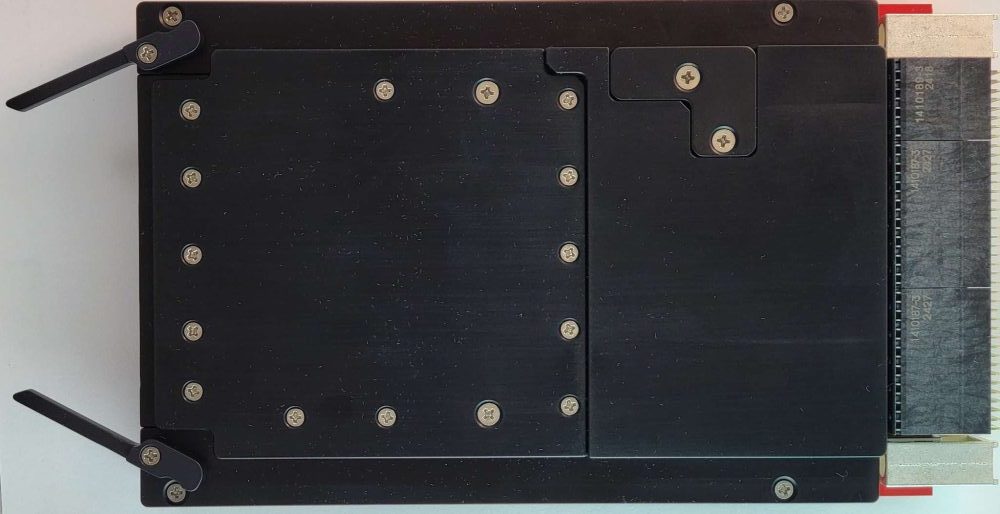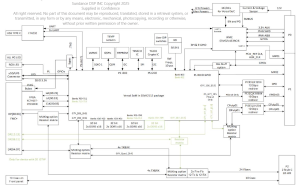The Solar Express 2000 (SE2000) is a 3U SOSA-aligned OpenVPX PIC card based on the AMD Versal ™ AI Edge and Prime Gen 2 devices (The choice between an AI Edge or Prime device is an ordering option, the first available SE2000 module comes with a Versal AI Edge Series Gen 2 device in an SSVA2112 package, XC2VE3858-2MSISSVA2112; other devices will become available over time).
The board is suitable for high-speed data processing, analysis, and AI inferencing.
This VPX board has many advanced features, including optical and RF interfaces and an FMC+ connector for additional flexibility and expandability. It comes with an AMD Artix™ FPGA, which acts as a voltage translator between the AMD Versal and the FMC+ connector supporting the traditional voltages offered by FMC+ modules.
The board is designed for defense, aerospace, and research applications.
Features
The hardware will have the following features:
- Board form factor and Profile, SOSA compatible: MOD3-PAY-1F1U1S1S1U1U2F1H-16.6.11-x
- SOSA slot profile SLT3-PAY-1F1U1S1S1U1U2F1H-14.6.11-6 (other “dash” options are supported — contact Sundance support for more information)
- IPMC: STM32L433RCI6 microcontroller
- Main payload devices available as ordering options:
SSVA2112 package, Versal AI Edge Gen2 2VE3504, 2VE3558, 2VE3804, 2VE3858, Versal Prime Gen2 2VM3558, 2VM3858 - GTYP, GTM resource allocation:
GTYP(PL) – 12 (Max 20), GTYP(PS) – 4, X5IO – 384 (Max 512) (SSVA2112 package) - 16 GB eMMC for PS image and data storage (can populate up to 256 GB)
- Two 1 GB QSPI flash for PS image and data storage
- TA101 Secure authentication IC connected to PS for secure boot and encryption capabilities
- TPM 2.0 for storage of encryption keys for the PS, ST33HTPH2X32AHE4
- Si5341 Clocking IC (10 outputs, low jitter)—provides fabric clocks and transceiver clocks
- FT4232 USB-to-UART: provides 3 UART channels (payload PS, payload PL, IPMC) and JTAG (including FMC+) via USB Type-C connector
- DIP switches for JTAG bypass, boot-mode selection, and user purposes
- Two RGB LEDs (one connected to PS, one to PL)
- IPMC SWD JTAG routed to the OpenVPX connector
- Combined MicroSD/UFS card connector—boot capable (microSD supports only 3.3 V modes)
- Maintenance ports routed to IPMC and to Payload PS UART
- Redrivers on Data, Control, Expansion plane signals:
PI3EQX16904GLZHEX (Expansion plane), PI3EQX1204-CZHEX (other planes) - Optical module with 12 Tx and 12 Rx lanes (to build 3×100 Gb Ethernet ports)
- There is constant GTYP routing not controlled by assembly option, not subject to change:
- PS GTY_Q_105 — routed to Expansion Plane EP00–EP03 (PCIe only)
- 4× PL GTYPs[00:03] — routed to Data plane 1
- There are stuff resistors for different assembly options, routing GTYPs to different interfaces:
- For devices with 12 GTYPs:
- 4× GTYPs[04:07] — FMC+ DP[00:03] or Optical
- 2× GTYPs[08:09] — FMC+ DP[04:05] or Optical
- GTYP[10] — FMC+ DP[06], Optical, or DPutp01
- GTYP[11] — FMC+ DP[07], Optical, or CPutp01
- For devices with 20 GTYPs:
- 4× GTYPs[08:11] — FMC+ DP[04:07] or Optical
- 4× GTYPs[12:15] — FMC+ DP[08:11] or Optical
- GTYP[16:17] — FMC+ DP[12:13]
- GTYP[18] — DPutp01
- GTYP[19] — CPutp01
- For devices with 12 GTYPs:
- Voltage & current sensing IC for the 12 V rail only, connected to IPMC and Payload via SMBus (other rails provide PG signal only)
- Temperature sensing IC connected to IPMC via I²C
- Onboard power control per OpenVPX specification, via IPMC
- Requires chassis 12 V supply and 3.3 V AUX supplies
- Enclosure compliance: VITA 48.2 conduction cooling and VITA 48.8 air cooling
- IPMC features:
- NVMRO signal processing
- IPMA, IMPB ports routed
- PMBus access with power & temperature sensors
- SWD JTAG routed from OpenVPX connector to IPMC
- Maintenance port from OpenVPX connector to IPMC
- GDiscrete1, GPIO1, MASK_RESET#, VPX_SYSCON#, GA[0:4], GAP routed to IPMC
- Early 3.3 V AUX warning
- Payload power control
- Internal PG signals
- IPMC to Payload connections & features (air-gappable):
- 1 SPI interface
- 9 GPIOs and 1 RESET#
- OpenVPX signals (GDiscrete1, SYS_CON#, GPIO1, MASK_RESET#) can route directly to Payload via resistor stuff option
- XC7A15T-1FGG484I FPGA for FMC LA/HA lanes level translation
- FMC+ VADJ voltage support: 1.8 V, 2.5 V, 3.3 V
- Maximum power draw: 200 W (TBD) from 12 V rail
Applications
- AI inferencing
- Defense
- Medical
- Imaging
- Software Defined Radio
A complete BSP with Linux driver will be supplied.
SE2000-xx where “xx” can be any of the -n P2 connectors options shown in the table below
| “-n” option | Description |
| -0 | No P2 connector installed |
| -4 | Direct RF to P2 backplane |
| -6 | Hybrid Optical/RF to P2 Backplane |
| -14 | Optical aperture for P2 backplane |
| -TBD | Other options may be supported. Please contact Sundance DSP support for more information |
Early access to this board can be granted to interested customers, but the estimated delivery for prototype version will be Q3 of 2025.



